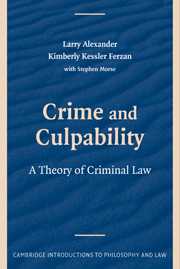27 results
Investigating the Public Health Impact of Hurricane Sandy
-
- Journal:
- Disaster Medicine and Public Health Preparedness / Volume 10 / Issue 3 / June 2016
- Published online by Cambridge University Press:
- 13 June 2016, pp. 301-303
-
- Article
- Export citation
Coping Behavior and Risk of Post-Traumatic Stress Disorder Among Federal Disaster Responders
-
- Journal:
- Disaster Medicine and Public Health Preparedness / Volume 10 / Issue 1 / February 2016
- Published online by Cambridge University Press:
- 23 December 2015, pp. 108-117
-
- Article
- Export citation
13 - Neuroscience, free will, and criminal responsibility
- from Part V - Legal implications of neuroscience
-
-
- Book:
- Free Will and the Brain
- Published online:
- 05 October 2015
- Print publication:
- 18 September 2015, pp 251-286
-
- Chapter
- Export citation
Contributors
-
-
- Book:
- The Cambridge Dictionary of Philosophy
- Published online:
- 05 August 2015
- Print publication:
- 27 April 2015, pp ix-xxx
-
- Chapter
- Export citation
Contributors
-
-
- Book:
- Maternal Critical Care
- Published online:
- 05 July 2013
- Print publication:
- 04 July 2013, pp ix-xiv
-
- Chapter
- Export citation
Bibliography
-
- Book:
- Crime and Culpability
- Published online:
- 05 June 2012
- Print publication:
- 16 March 2009, pp 331-348
-
- Chapter
- Export citation
Index
-
- Book:
- Crime and Culpability
- Published online:
- 05 June 2012
- Print publication:
- 16 March 2009, pp 349-358
-
- Chapter
- Export citation
PART FOUR - A Proposed Code
-
- Book:
- Crime and Culpability
- Published online:
- 05 June 2012
- Print publication:
- 16 March 2009, pp 261-262
-
- Chapter
- Export citation
4 - Defeaters of Culpability
-
- Book:
- Crime and Culpability
- Published online:
- 05 June 2012
- Print publication:
- 16 March 2009, pp 86-168
-
- Chapter
- Export citation
8 - What a Culpability-Based Criminal Code Might Look Like
-
- Book:
- Crime and Culpability
- Published online:
- 05 June 2012
- Print publication:
- 16 March 2009, pp 263-324
-
- Chapter
- Export citation
PART TWO - The Culpable Choice
-
- Book:
- Crime and Culpability
- Published online:
- 05 June 2012
- Print publication:
- 16 March 2009, pp 21-22
-
- Chapter
- Export citation
Appendix
-
- Book:
- Crime and Culpability
- Published online:
- 05 June 2012
- Print publication:
- 16 March 2009, pp 327-330
-
- Chapter
- Export citation
3 - Negligence
-
- Book:
- Crime and Culpability
- Published online:
- 05 June 2012
- Print publication:
- 16 March 2009, pp 69-85
-
- Chapter
- Export citation
Contents
-
- Book:
- Crime and Culpability
- Published online:
- 05 June 2012
- Print publication:
- 16 March 2009, pp ix-xii
-
- Chapter
- Export citation
Frontmatter
-
- Book:
- Crime and Culpability
- Published online:
- 05 June 2012
- Print publication:
- 16 March 2009, pp i-viii
-
- Chapter
- Export citation

Crime and Culpability
- A Theory of Criminal Law
-
- Published online:
- 05 June 2012
- Print publication:
- 16 March 2009
6 - When Are Inchoate Crimes Culpable and Why?
-
- Book:
- Crime and Culpability
- Published online:
- 05 June 2012
- Print publication:
- 16 March 2009, pp 197-225
-
- Chapter
- Export citation
Acknowledgments
-
- Book:
- Crime and Culpability
- Published online:
- 05 June 2012
- Print publication:
- 16 March 2009, pp xiii-xiv
-
- Chapter
- Export citation
5 - Only Culpability, Not Resulting Harm, Affects Desert
-
- Book:
- Crime and Culpability
- Published online:
- 05 June 2012
- Print publication:
- 16 March 2009, pp 171-196
-
- Chapter
- Export citation
Epilogue
-
- Book:
- Crime and Culpability
- Published online:
- 05 June 2012
- Print publication:
- 16 March 2009, pp 325-326
-
- Chapter
- Export citation



